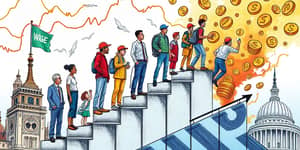
In 2025, many households around the world continue to feel the impact of elevated prices for essentials. While overall inflation has eased from its post-pandemic peaks, food and energy prices remain volatile, creating new challenges for families, businesses, and policymakers. This article explores the causes of persistent inflation in these critical sectors, the human stories behind the numbers, and practical strategies to build resilience in everyday life.
Food prices have surged by 2.9% in the United States over the past year, mirroring a broader trend across the OECD where year-on-year increases reached 4.5% in April 2025. Several interlinked factors explain why grocery bills keep climbing:
Forecasts from the USDA suggest that overall food inflation will average 2.9% in 2025, with groceries rising by 2.2% and dining out by 3.9%. This dual pressure on both food-at-home and food-away-from-home costs highlights the persistent budget strain facing consumers.
After a steep climb in 2021–2022, energy prices have shown mixed signs. In the United States, the energy index fell by 3.5% year-on-year through May 2025, yet regional disparities remain stark. OECD data for April 2025 records a slight 0.2% decline, even as some countries experienced sharp increases due to policy shifts:
This volatility reflects deep structural factors. Economies heavily dependent on imported fuels face exposure to global market swings, while domestic policies on taxes, caps, and subsidies can sharply alter local prices overnight. Moreover, the passthrough of energy costs into manufacturing and transportation continues to ripple through other sectors, reinforcing inflationary pressures.
Inflation is more than a statistic: it shapes daily choices and aspirations. For many low- and middle-income families, the rising cost of groceries and utilities means:
Research shows that households allocate a higher share of income to necessities when food and energy prices rise. This shift often translates into less spending on healthcare, education, and community activities, with long-term consequences for well-being and social cohesion.
Yet, in neighborhoods around the world, inspiring examples of community action have emerged. Urban gardens supply fresh vegetables at subsidized rates, cooperative bulk-buy programs negotiate lower grocery prices, and local workshops teach energy-saving habits. These grassroots efforts illustrate how collective ingenuity can ease the burden of inflation.
While systemic solutions require policy action, individuals can adopt practical measures today to protect their budgets. Consider the following approaches:
Small actions compounded over time can yield substantial savings. For example, lowering the thermostat by just one degree in winter can trim energy costs by 2%–3% without sacrificing comfort.
Addressing persistent inflation in food and energy sectors ultimately hinges on policy-driven solutions that ensure stability and equity. Key areas for government action include:
Central banks face a dual mandate: contain inflation through prudent interest rate settings while supporting economic growth. Balancing these objectives is particularly delicate when core inflation hovers around 4.6% and headline rates remain elevated compared to the pre-pandemic era.
The table below summarizes key inflation metrics, illustrating the persistence and divergence of price pressures across sectors and regions.
Looking ahead, markets anticipate modest relief as supply chain pressures ease and renewable energy scales up. However, sectoral price rigidities and geopolitical uncertainties could reintroduce shocks, underscoring the need for continual adaptation and vigilance.
Inflation in food and energy sectors touches every corner of society—from individual households juggling budgets to national policymakers charting economic courses. While challenges remain, the convergence of consumer ingenuity, community solidarity, and forward-looking policy offers a roadmap to greater stability.
By embracing long-term resilience strategies—whether through smarter household choices or collective advocacy—we can mitigate the impact of persistent inflation and build more equitable, sustainable economies. In doing so, we transform a daunting crisis into an opportunity for innovation and shared prosperity.
References













